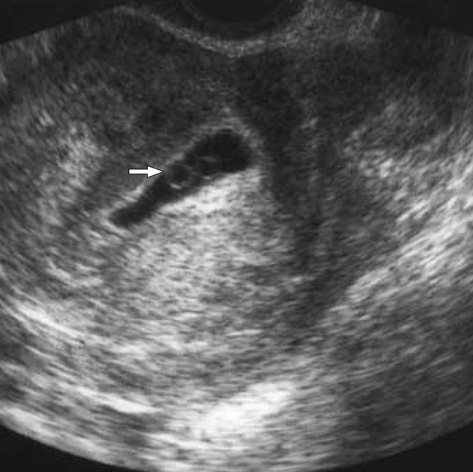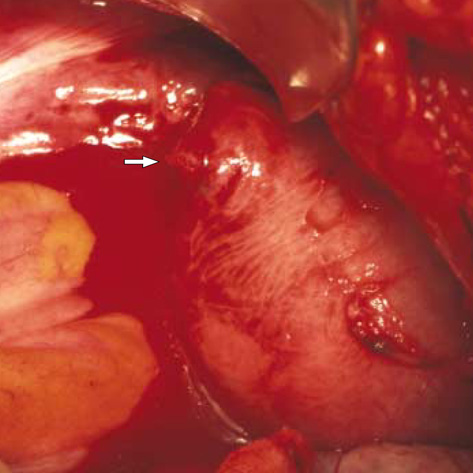J Korean Med Sci.
2005 Dec;20(6):1079-1081. 10.3346/jkms.2005.20.6.1079.
Spontaneous Uterine Rupture in the First Trimester: A Case Report
- Affiliations
-
- 1Department of Obstetrics and Gynecology, Kwandong University College of Medicine, Myongji Hospital, Koyang, Korea. pyjoon@kwandong.ac.kr
- 2Department of Surgery, Kwandong University College of Medicine, Myongji Hospital, Koyang, Korea.
- 3Department of Obstetrics and Gynecology, Hanyang University.College of Medicine, Seoul, Korea.
- KMID: 2157768
- DOI: http://doi.org/10.3346/jkms.2005.20.6.1079
Abstract
- Uterine rupture is one of the most feared obstetric complications affecting the pregnant woman and fetus. Most of the cases have various risk factors and mainly occur during the second or third trimester. However, spontaneous uterine rupture during the first trimester is extremely rare. We experienced a case of spontaneous uterine rupture in a 36-yr-old multiparous woman without definite risk factors. The initial impression was a hemoperitoneum of an unknown origin with normal early pregnancy. Intensive surgical method would be needed for accurate diagnosis and immediate management in bad situation by hemoperitoneum even though a patient was early pregnancy.
MeSH Terms
Figure
Cited by 1 articles
-
A Case of Successful Conservative Management for Spontaneous Hemoperitoneum in the 3rd Trimester Pregnancy
Jin-Gon Bae, Joon-Cheol Park, Jeong-Ho Rhee, Jong-In Kim
Korean J Perinatol. 2014;25(1):27-32. doi: 10.14734/kjp.2014.25.1.27.
Reference
-
1. Turner MJ. Uterine rupture. Best Pract Res Clin Obstet Gynaecol. 2002. 16:69–79.
Article2. Kieser KE, Baskett TF. 10-year population-based study of uterine rupture. Obstet Gynecol. 2002. 100:749–753.3. Kong KY, Chang SK, Kim YJ, Lee JY, Chung JK. A clinical evaluation on the rupture of the gravid uterus. Korean J Obstet Gynecol. 1993. 36:1486–1490.4. Suner S, Jagminas L, Peipert JF, Linakis J. Fatal spontaneous rupture of a gravid uterus: Case report and literature review of uterine rupture. J Emerg Med. 1996. 14:181–185.
Article5. Cunningham FC, Gant NF, Leveno KJ, Gilstrap LC III, Hauth JC, Wenstrom KD. Obstetrical hemorrhage. Williams Obstetrics. 2001. 21st ed. McGraw-Hill;619–669.6. Sallam AH, Preston J. Idiopathic uterine perforation in late pregnancy. J Obstet Gynaecol. 2002. 22:317.
Article7. Miller DA, Goodwin TM, Gherman RB, Paul RH. Intrapartum rupture of the unscarred uterus. Obstet Gynecol. 1997. 89:671–673.
Article8. Berghahn L, Christensen D, Droste S. Uterine rupture during second-trimester abortion associated with misoprostol. Obstet Gynecol. 2001. 98:976–977.
Article9. Mishra A, Landzberg BR, Parente JT. Uterine rupture in association with alkaloidal cocaine abuse. Am J Obstet Gynecol. 1995. 173:243–244.10. Chan LY, Yu VS, Ho LC, Lok YH, Hui SK. Spontaneous uterine perforation of pyometra: a report of three cases. J Reprod Med. 2000. 45:857–860.11. Ding DC, Chu TY, Liu JY. Menstruation-induced uterine rupture. Int J Obstet Gynaecol. 2000. 69:171–172.
Article12. Biljan MM, Cushing K, McDicken IW, Garden AS. Spontaneous uterine rupture in the first trimester of pregnancy. J Obstet Gynecol. 1996. 16:174–175.
Article13. Choi KD, Choi HK, Lee HS, Kim CB, Lee GN. A case of spontaneous rupture of the uterus with placenta increta in early pregnancy. Korean J Obstet Gynecol. 1996. 39:1359–1364.
- Full Text Links
- Actions
-
Cited
- CITED
-
- Close
- Share
- Similar articles
-
- Repetitive Spontaneous Uterine Rupture in the First Trimester after Laparoscopic Myomectomy: A Case Report and Review of Literature
- A Case of Spontaneous Uterine Rupture in the Second Trimester of Pregnancy
- Spontaneous uterine rupture during second trimester
- A Case of Uterine Rupture in the 18th Week of Pregnancy
- A Case of Spontaneous Uterine Rupture due to Placenta Percreta on 1st Trimester




